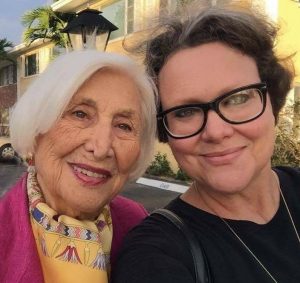
I have never been a mother. But I am a daughter and have observed my mother and I over the course of fifty-five years. As I reflect on our years, most of them spent living together, I have an appreciation of what this relationship has meant in my life. Because surely, this has been my longest relationship, and has had the greatest impact in forming who I have become.
Around three this morning, I woke thinking of how four Biblical scenes from the life of Mary, the mother of Jesus, illustrate the arc of a mother’s life. I tapped a few thoughts in an email to myself and went back to sleep.
I sat with these notes this morning, considering what these moments felt like from Mary’s perspective and then imagined similar turning points during my relationship with my mother. What could these passages in Mary’s life teach me about what it means to be a mother, to be a daughter, to live a life in full by surrendering to someone else and to God?
When we first meet Mary as a young woman, she is visited by an angel and asked if she is willing to become the mother of God. Her answer is yes. Imagine the courage of that moment. To say yes, to the unknown. To say yes to God.
Each day around the world, women make a similar yes to hope and love and possibility when they give birth to their child. No matter how difficult the circumstances there must be a moment when they gaze into the eyes of their child, still linked to their body, and see a limitless future.
My earliest memory of my mother is being held in her outstretched arms as she glided backwards in a sun-filled pool, teaching me to swim. I was ecstatic, so joyful in the sun and water and my mother’s secure hold on my three-year-old body. Her smile was the center of my universe.
In a second milestone of Mary’s life, Mary and Joseph and twelve-year-old Jesus, have traveled to Jerusalem. On their way home, Mary and Joseph realize that Jesus is not with them. They return to Jerusalem and discover him in the temple, sitting among the religious teachers, listening and asking questions. From a Biblical perspective, this moment is meant to provide the first glimpse of who Jesus truly is. But let’s consider this scene from Mary’s perspective. Perhaps this is the instant when she first experiences her child’s independence, his identity apart from her.
I imagine most mothers might wince as they recall what this age foretold in the life of their child. Instead of calmly sitting with religious leaders, their child began to show the first signs of rebellion. This is the moment when mother and child instinctively acknowledge that for personal growth to begin they must grow into their differences.
At the age of twelve, I stopped speaking to my mother. I became a sullen child certain that no one understood me. I wanted to be everywhere but home. And when I was home, I was in my room with the door closed. I became by turns, emotionally isolated from my family, wildly extroverted with my swim teammates, and terribly selfish in what I needed to fill my loneliness.
In the third scene from Mary’s life, she attends a wedding with her son, Jesus. The host of the wedding runs out of wine and Mary asks Jesus to intervene. Like most young adults who are asked by their parents in public to do anything, Jesus at first says no. Then, like most young adults, after he has asserted his independence, he turns around and does as his mother has asked.
When I left college, I went to work in New York. My mother and I were still barely speaking, but it was agreed that I would come home once a year at Christmas. One year, after a particularly painful phone call, I told my mother I would not be coming home for Christmas and hung up the phone. I wanted to assert my independence. And I wanted my mother to know how my heart was hurt, by hurting her with my absence. It only took me a few days to call back and reschedule my visit. It was a turning point in which I knew that no matter what physical and emotional distance separated us, there was a bond of love beneath that I could not bear to lose.
Where do we go from here?
In the final scene in Mary’s life, we find her weeping at the foot of the cross as her son, Jesus, is crucified for our sins. We are taught about God’s love for us, about a child’s love for his mother, and a mother’s love for her child. In his final moments, Jesus expresses his love for his mother by instructing one of his disciples to care for her. And what must she be thinking in this moment? Does her entire life with Jesus flash before mind’s eye, joy and sorrow tumbled together?
Mom and I lived together for twenty years after my father passed. We were both adults, my mother was in fact retired. Over time, we learned to put away our swords, those words we knew pierced the heart the deepest. In their place, we came to respect each other as women, and then we learned to love each other as mother and daughter.
The final scene in the Biblical life of Mary and Jesus is about the many layers and meanings of love. This final season in the life of my mother and I, is about learning to love one another despite years of separation and recrimination and second guessing about what we could have done better. I would not trade a single moment of our journey together. Because it brought us here.
I love my mother more than I ever dreamed possible. Not because either one of us is perfect. But because we love each other while embracing our imperfections. Because we understand that these are the very things that have taught us that the gift of pain is humility. The gift of humility is the ability to be less, so we can give more. To experience heartbreak so we can fathom the suffering of someone else. Because of our jagged history, we are better able to be who we were meant to be and to serve God as he would want us to do.

